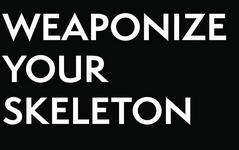It’s Different for Me: A Woman’s Perspective on Hand-to-Hand Combat Training

Note: The following was sent to us by a female client who wanted to share this on our blog, but wishes to remain anonymous.
~~~
People who don’t know me well would never imagine that I know anything about or have any interest in hand-to-hand combat training and I like it that way. It isn’t comfortable social conversation to talk about what that really means and I don’t want to defend what I know, why I know it, and what that means for me. People take a step back and wonder about you when you admit, with conviction, that yes, you would jab your thumb into someone’s eye socket or stomp their knee to render their leg useless if necessary. If it is their life or mine, I will always choose mine.
I have trained with men—big men, who far out-muscle and out-weigh me. I have been fortunate that they are some of the best trained instructors in the world and they care about my safety and well-being. They train hard and when they pin me against a wall with their hands on my throat or grab me in a bear hug and lift me off my feet, they will not release me just because I tried. They will let me go only if I hit my targets and they are forced to let me go by the laws of physics and human anatomy.
During training you move slow, slower than a violent confrontation would be if this were real. I know it is to keep everyone safe and to pay attention to targets, but for me there is another reason for going slow—to connect with the fear. When a man who is taller than you by at least a foot, with biceps as big as your thighs, pins you against the wall, hands on your throat, make no mistake about it, there is fear. I must drink in that fear—I need to feel it and pay attention to it. I have known my instructor for years and I trust him, so my feelings of fear are less pronounced than they would be in a violent situation with a stranger; therefore, in training I must tap into that fear, feel it, focus on it, and pay attention to how my body and mind respond in a fear state. It is a gift to be allowed to train slow, to be able to pay attention to your physiological responses to fear, and to figure out how to stay focused on targets. I have learned what it feels like to stay focused on targets that cause injury to another human being when I am pinned against a wall with hands around my throat, my heart racing, and my mind consumed by the need to survive.
Early in my training I had not yet learned the value of paying attention to how my brain and body respond to fear. None of my instructors talked about it and I did not admit that I felt fear—we were only training after all, what was there to be afraid of? I honestly do not know if my instructors didn’t talk about paying attention to your fear response because they didn’t experience it during training or if it is one of the subtle nuances of training that you don’t realize is valuable until someone points it out to you. I still vividly remember learning this lesson. It was early in my training and I was doubting my abilities. I decided that to build my confidence I needed to put myself into a situation where I knew my fear response would be triggered, so I asked my training partner to sit on my chest and pin my hands to the ground. It was at that moment that I learned not only to pay attention to how my mind and body reacts in a fear state, but I learned an entirely new lesson—the dramatic increase in the intensity of both my fear and other emotions that are triggered when violence and intimacy intersect.
The intensity of the fear response at the intersection of violence and sexuality is an aspect of training that I believe may be unique to women or at least much more prevalent for women. It is not something my instructors ever talked to me about, and honestly I am not sure that I would have welcomed the discussion because it is deeply personal and difficult to express. Prior to training I did not engage in any co-ed contact sports that required close physical contact with men. However, during training there are times when I find myself in positions with my training partner that I had previously only experienced in non-violent, consensual, intimate relationships. It is in these moments during training that my brain will sometimes trigger the recognition of the potential for a situation to be sexual and because I am a socialized and decent person who respects her training partner, my first response is to ignore those thoughts. However, I believe for women to get the most out of their training they need to tune in to these moments when they occur and place them squarely in the context of violence. Women must seize these moments and become fully present in their thoughts, feelings, and physiological responses associated with sexual violence so that they can understand how their mind and body might respond in similar situations outside of training. I will admit tuning into these moments during training is a terrible feeling wrought with intense emotion and a feeling I would much rather avoid all together, but I know I am not taking full advantage of my training if I ignore these moments and turn away.
Our male training partners and instructors need to know how valuable these moments are for us. These situations provide us with valuable opportunities to push back on a lifetime of teaching that reminds women and girls that we are vulnerable to violent confrontations in everyday activities like jogging along a path or walking through a parking lot. To further compound this narrative, historically women in our society have not been trained to respond to violence with effective techniques using our own bodies as weapons. Instead we are reminded frequently through media and social stories that we are not capable of effective response to violence and that in order to be effective we need to use devices that someone, somewhere thought would help us feel safer such as carrying a whistle or mace. However, these tools and devices so often pitched to women promote the narrative that women are not capable of inflicting debilitating injury on attackers who are bigger and stronger than they are, but effective training changes all that. After all, a crushed windpipe from a knee drop to the throat is still a crushed windpipe no matter who delivers it.
It has been several years now since I first learned the value of leaning into my fears and walking along that dark edge of intimacy and violence. I think it is one of the most important aspects of training for woman. The sessions on grabs, holds and chokes can really surface these fears and emotions, and for women who are rape survivors the intensity of the response to this aspect of training is even more pronounced because of their ties to a history of sexual violence. Over the years I have also watched and listened as the instructors have learned more about this aspect of training and how it is experienced by their female students. I am impressed by the compassion the instructors show in these moments as they continue to teach, but lean into the fears and emotions of their female students and encourage them to pay attention to their emotional and physiological response while also channeling their energy and strength to continue fighting. It has truly been a gift to be trained by and to watch these instructors. They are fathers, sons, brothers, and husbands and they care for their students like family and give generously of their time to ensure that every student succeeds. In all of my training I have always felt that my instructors believed in my ability to deliver a crippling injury to an attacker and that my knowledge of effective techniques was the most important tool they could give me for my own safety. They train me with a level of intensity that communicates to me that my life depends on it because the reality is that someday it might.
— Anonymous


See also: Mama Said Knock You Out: Women in Hand-to-Hand Combat Training